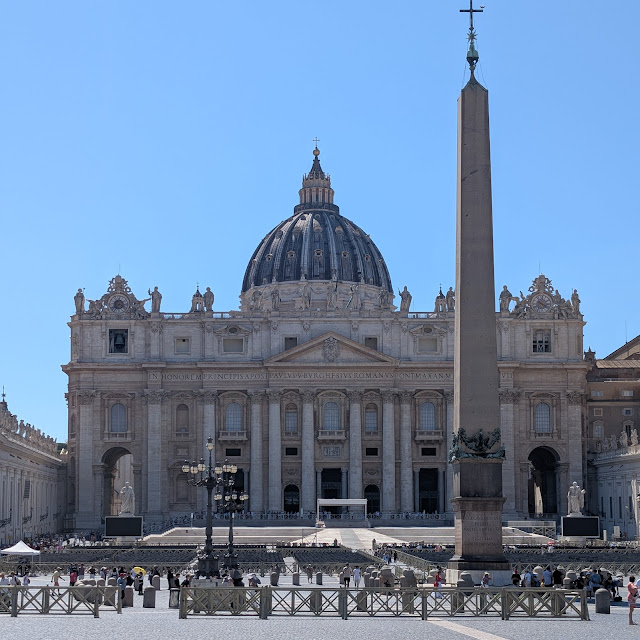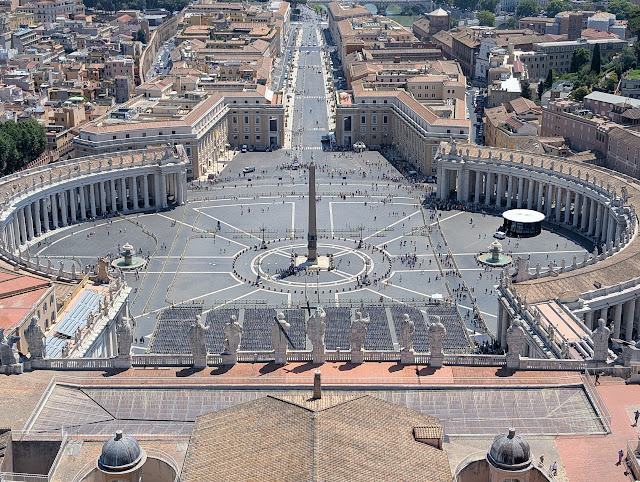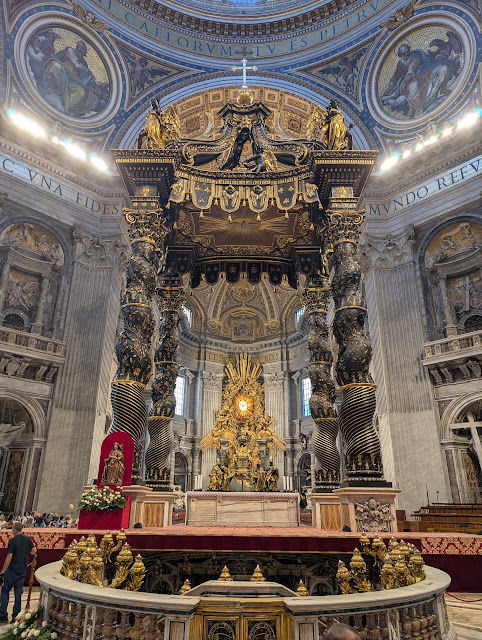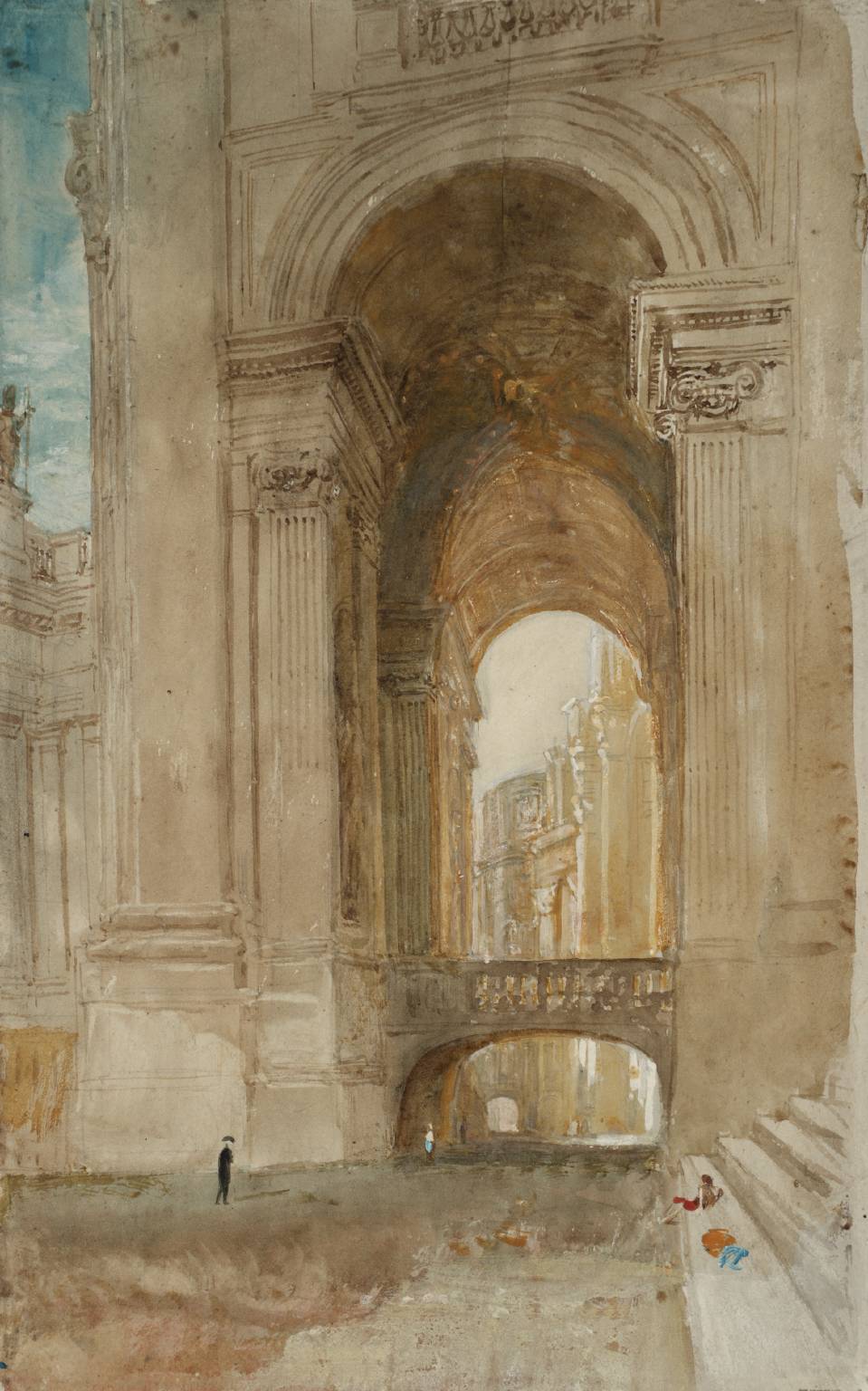Yesterday, we visited St. Peter’s Basilica in Vatican City, Rome.
The experience of walking through St. Peter’s is the closest thing to being in heaven. It’s hard to convey the sheer immensity and majesty of St. Peter’s.
Walking through St. Peter’s, you can feel the Catholic Church of the 17th century conveying it’s belief that it, and only it, can lay claim as representatives of God on Earth. Especially, after the sack of Rome in the early 16th century and rapid expansion of the Reformation throughout Northern Europe.
The Catholic Church’s Counter-Reformation is the entire reason that St. Peter’s is so overwhelming: full of power and emotion, action, and meticulous detail. It’s the Baroque; and St. Peter’s is the acme of Baroque architecture: striking, golden, and extravagant with no reservations.
Below are some of the photos I took on the day.
✲✲✲
The Nave of St. Peter’s
Pure breathtaking magic.
The nave was decorated by Bernini who was commissioned by Pope Innocent 10th in 1645. But, it was designed and built mostly by Carlo Maderno. It’s full construction spanned over a hundred years and included contributions from architects like Bramante and Michelangelo.
I tried to take some photos with people to give an impression of height. It is 45-46 meters tall.
✲✲✲
The façade of St. Peter’s Basilica

Entry to the Basilica and climbing after the lift
We booked the “Dome with the lift” ticket. Fortunately, we managed to wizz past the crowds with our pre-booked tickets. It wasn’t nearly as crowded as I expected. (Probably because it wasn’t a weekend?) Nevertheless, despite getting the “lift” ticket, there were some serious steps to climb ... Upwards in tight and winding cases.
✲✲✲
The view from the Dome of St. Peter’s
✲✲✲
St. Peter’s Baldachin and the Papal Altar
Bernini’s Baldachin is an ancient part of the Basilica (dating back to the construction of Constantine’s Basilica). It is the largest bronze sculpture of the Roman Baroque.
It is directly under the Dome and sits above St. Peter’s tomb.
✲✲✲
Bernini’s monumental “Cathedra Petri” (AKA: the Chair of St. Peter)
This was hard to photograph as I couldn’t get too close.
It is a gilded bronze sculpture enveloping the throne of St Peter (at the apse of the Basilica). The “throne” is a wooden chair which is considered a relic. Just like the shroud of Turin, it is unbelievable to imagine that that was the same chair of Saint Peter himself. Anyway, I couldn’t get too close so I couldn’t see it. It seems it’s been replaced now with a table and the relic in safe storage.
At any rate, just like the Baldachin over the main altar, the Cathedra Petri was designed by Bernini also. It has an immense visual and symbolic impact.
✲✲✲
The Domes (from within)
✲✲✲
The Pietà by Michelangelo Buonarroti
This beautiful statue is like the Mona Lisa – it’s too far away to really see it.
It sits 20 feet behind a glass wall. Some maniac previously tried to smash Mary’s face with a hammer.
So, as you can see, I couldn’t see it very well.
Not enough to discern the intricacies of human flesh and emotions between Mother and Son.
But I had (like everyone else) already seen so many images of Michelangelo’s Pieta, and I’m aware of the technical genius. Like Leonardo da Vinci’s St. Anne painting, he is able to cast a figure physically over another without it seeming awkward or malpositioned. Then, there’s the v. subtle emotion of tragedy of a mother losing her son in such a brutal and violent way. And, Michelangelo portrays her quiet strength and dignity as much as her love towards God and her son.
✲✲✲
The bronze statue of Saint Peter
Beautiful statute from the 5th century. Attributed to Arnolfo di Cambio.
✲✲✲
Confessional
✲✲✲
The Tomb of Pope Alexander VII by Bernini (Bernini’s last major work)
✲✲✲
Various statues
✲✲✲
The Arco delle Campane with the Swiss Guard
This view was painted by JMW Turner:
✲✲✲








































What an amazing church! Beautiful photos, Liam! Thank you so much for sharing.
ReplyDeleteThank you for reading it Linda.
DeleteWhat absolutely marvelous photos you took of St Peter's Basilica! They brought back many memories of our afternoon there. We didn't go up the Dome but wow, what a breathtaking view from the top -- worth all those narrow, claustrophobic steps. Seeing Michelangelo's Pieta, even at a distance and behind plexiglass, was a bucket-list moment for me. I've loved that statue since I was a teenager.
ReplyDeleteSt Peter's is indeed overwhelming in its sheer size, magnificent art, display of wealth, and assertion of Christian Triumphalism. As a non-Christian, I found many aspects of it rather off-putting after the initial "shock and awe" of its architecture and displays wore off. My fondest memory of St Peter's is standing near the Bronze Canopy at the heart of the Basilica with my partner and doing a private little ritual to reclaim the sacred space for Magna Mater, the Great Mother Goddess whose temple once stood on that spot and which was destroyed by the early Christians when they became the State Religion of Rome. Hey, better late than never!
Hi Debra,
DeleteThanks for commenting.
On the subject of Christianity, it is worth asking just how much of the St Peters, the various Basilicas of Rome, and even the Church itself, is truly "Christian" (i.e. Hebrew) or simply the impact of Zoroastrianism and paganisms. The Pantheon itself today operates as a Catholic Church where mass is celebrated. And yet, it used to be an ancient Roman temple. In the Sistine Chapel's Michelangelo's Last Judgment, he paints (at the bottom) a small wooden boat to take souls to the next world (hell). This is clearly a nod to the ancient roman beliefs and not Christianity/Hebrew doctrine.
I think the doctrine of the Trinity and the idea of Christ as the son of God (asopposed to a being a mere prophet) derives from the Greco-Romano tradition and NOT from the early Jewish Christianity. So many things in the Christian faith are taken for granted as being authentically Christian, but have very dubious origins in the broader pagan or secular ideas of their time. Like Satan/Lucifer. Christians casually talk about "the devil" but that owes a lot to the impact of Zoroastrianism, and the other pop culture works of Dante's Divine Comedy and Milton's Paradise Lost.
As for your private rituals, do a little prayer to Apollo, he's the god of the gays. 😊
Oh, I agree. Christianity right from the start stole imagery, myths and spiritual teachings from EVERYBODY, and recasted it all starring *Jesus*.
DeleteP.S. Don't forget Apollo's twin sister Diana, goddess of independent women and lesbians everywhere!
That is just sheer splendid architecture and design. So good to be there
ReplyDeleteThank you Roe 😊
DeleteEverything is totally awe-inspiring, your photos tell us that the creation of beautiful objects was foremost in the minds of the artists and the church. It is as if religious belief was made for art, and yet......
ReplyDeleteHi Thelma,
DeleteThanks for commenting. It is all very awesome.
It's all propaganda & manipulation to be honest. What matters is the skill and culture that allowed artists to tell a story that was different to an earlier generation. :)
It is overwhelming, awe-inspiring and magnificent. One wonders about the nameless hundreds of workers who created the mosaics and carved the stonework - unsung, like so many master craftsmen.
ReplyDeleteThank you for the tour, Liam. You look very cool, despite the intense heat.
😊
DeleteBreathtaking indeed as I understand it's a magic beautiful place hard to describe, you did well.
ReplyDeletePhotos are just gorgeous.
Enjoy.
Thank you Margaret.
Delete